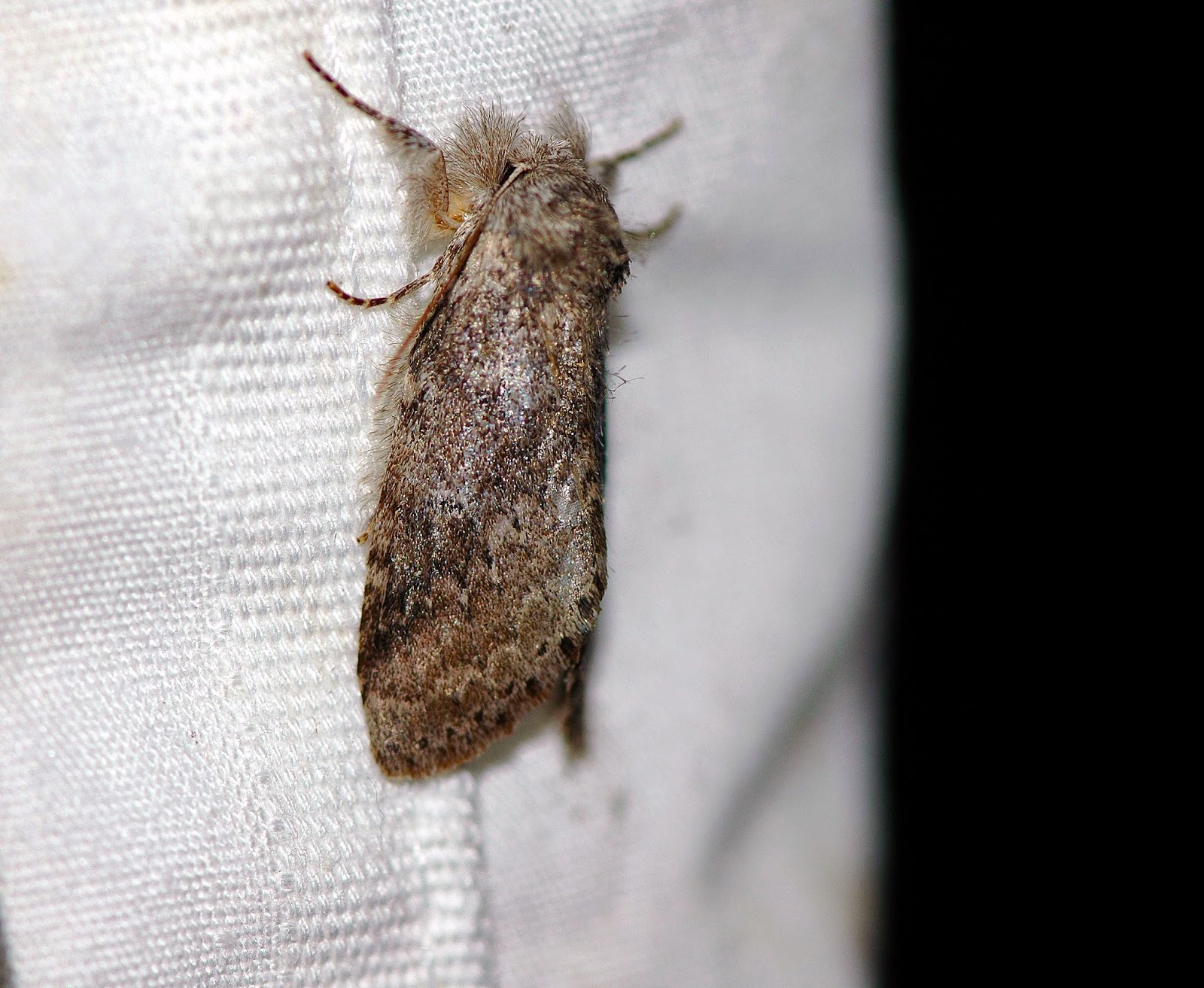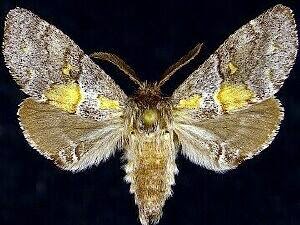Being Ohio is in the Eastern Deciduous Forest, we don't have large amounts of natural pine stands like you see west, south, and north of us. Members of the pine family are Conifers or cone producers. Just because it has a cone doesn't make it a pine, as we'll see in a minute. Let's take a quick look at some of the other non-pines found in the Pinaceae family.
Eastern, Western, and Carolina Hemlock (Tsuga) have short flat needles that tend to grow on one side or the other of the twig. The leaves or needles are green on top and white striped below. The cones are small, no more than an inch.
Larch or Tamarack (Larix). In Ohio there is a native species, as well as planted European and Japanese types. This is one of the few conifers that is NOT evergreen. The flat leaves grow out in pinwheel circles or whorls. They turn orange in the fall, drop to the ground, and leave the tree looking bare. Native Larch can be found growing in bogs.
Douglas-Fir, Pseudotsuga menziesii. This is a western U.S. species. Like the previous two, they also have flat needles, but grow spirally around the entire twig. The best way to identify it is by the three-pronged bracts that stick out between the cone scales. They resemble a mouse running back into his hole. Doug-Fir is hyphenated because the cone looks a bit like some of the true firs.
White and Blue Spruce, (Picea). Black and Red Spruce also occur in Eastern North America, but none of these species are native in Ohio. Norway Spruce is the most commonly planted. Spruce cones are more elongated and sausage like. Their needles also spiral around the twig, but upon feeling them they are sharply angled or square.
The True Firs, (Abies). There may be a few remnant populations of Balsam Fir in N.E. Ohio, but it is primarily a species found just north of us. The pictures are of White Fir, common in the Rockies. Fir trees have long flat needles. What makes them unique are the sucker discs at the bottom of each needle. Those circular pads even leave marks behind on bare twigs. The other thing that differentiates a fir tree is that instead of their cones hanging down, they grow UPRIGHT on top of the branches. Besides the two mentioned, there are at least another half dozen species along the Pacific coast.
Red Cedar, Juniper, White Cedar/Arbor Vitae, Cypress, Yew, Redwood, Sequoia, and Ginkgo are all related Gymnosperms, but belong to different families.
On to the pines. As you have just seen, a pine is not a pine just because it produces a cone. A pine tree (Pinus), is such because the needles are held together in bundles, clusters, or fascicles. Soft pines have needles in fives, the hard pines are in clusters of two or three.
White Pine, Pinus strobus. Perhaps the most commonly planted species in the state, or at least the most familiar. White Pine is native, especially in northern Ohio. It is our only five needled species found in the state. The needles are medium in length, and are soft to the touch. All of our other pines are rigid or stiff feeling.
The bark on young White Pine is smooth and solid black, something you won't see on any of our other pines.
As White Pine gets old, the bark will crack and form narrow fissures. This is still unique, as all the other pines will have a squarish or platy look. It can be brownish like this, or retain its blackish color.
White Pine, like other soft pines, have elongated cones rather than the short fatter cones one is used to seeing. There is often white pitch on the cone scales.
All pines tend to send their new growth branches out at the same spot. White Pine, more than other species, tend to have almost perfect whorls, and yes you can age the tree by counting the whorls.
White Pine is often planted as a good natural wind break. In Michigan there are a few virgin stands still left whose trees have a 6-7 foot diameter. Some pines are important timber species and are often raised in solid stands. Some are good for lumber, and they grow very fast. The vast majority have very porous wood, making them best used as pulpwood, otherwise known as paper making. The pitch or sap is used in tar and turpentine. Ever notice when you burn pine it pops a lot? Those compounds are used to make gunpowder. Most telephone poles are a type of pine.
Another native species is Virginia Pine, Pinus virginiana. Compared to White Pine, Virginia has short needles held together in fascicles of two. Also notice the needles are twisted, not around each other, each individual needle twists. They are often a paler green than other species.
All pine cones have bumps on each scale. With Virginia, they are heavily armed, having very sharp pointed tips, more so than other species. Virginia cones tend to stay on the trees for long periods of time, so the tree may be often packed with them.
The bark is platy like other hard pines, but the more you look at it, the more it seems sickly. The brownish-orange plates are smaller than other species, and it often looks like they start to peel or shag away from the trunk. Further up the tree, they actually do flake off, even on the live branches.
Another common characteristic is that this tree has a problem with self pruning. It frequently retains its dead branches, which adds a lot of knots to the wood. Because of this, I often call it the "Scarlet Oak" of pines. With its short, often pale needles, combined with the peeling bark and the retention of dead branches, it has the appearance of looking unhealthy. An old name for it was Scrub Pine.
A third native species is Pitch Pine, Pinus rigida. This is a three needled pine whose needles are twisted and of medium length, 3-5 inches. Considering the ground was completely covered in Lycopodium, it's no wonder I couldn't find any green needles.
Pitch Pine is a dark barked tree. The plates almost have a Wild Cherry look to them. The bark on very large and old specimens can turn orange. Pitch is a fire adapted species that may show new needles sprouting around the base after a burn. Pitch, along with Virginia, are common on dry ridge tops, and can form solid stands in such environments.
Scotch Pine, Pinus sylvestris. There are a number of non-native species planted around the state. Scotch is one of the most popular. It's hard to believe this drab looking tree is the most common pine used as a Christmas tree, but this is what you see for sale around the holidays. They look quite nice when small, but their appearance changes with age. The bark has a typical brown plated look in the lower part, but notice how it changes as you go up.
The upper half of the trunk begins to peel and show an inner bright orange bark. You can see this from a long distance away.
The needles on Scotch are short and in twos. They are usually straight, but some varieties may show a slight twisting. At first, that description matches Virginia, but the bark is different.
The cones are small, also similar to Virginia, but lack the sharp scale tips of that species. The scales are raised into a point, but with blunt tips.
Red Pine, Pinus resinosa. This species is native to the Northern Hardwoods Forest. That includes the Great Lakes region and the New England states, but not Ohio. The easiest way to recognize this species is the bark. Look for a red-orange color from top to bottom.
Some people are red-green color blind, and can not see that feature of the trunk. Try feeling for the texture. Rub the bark, and it falls off in very thin plates, like layered paper or pieces of the mineral Mica.
Red Pine has needles in twos. They are straight and considered long, 5-6 inches.
The needles are fragile, and when bent, easily snap in half like raw spaghetti.
I usually don't use buds to identify pines, mostly because they look alike, or you simply don't need them. Red Pine is different in having a single large, reddish orange bud, that the needles tend to whorl around.
Because the needles tend to bundle around that large terminal bud, I can look up and see what appear to be a bunch of baby porcupines or Koosh Balls at the end of the branches. I think I'm the only one that ever uses that character, but when Red is planted with other species, the needle length, and that "clustered at the end of the branches" appearance helps.
Another frequently planted species from Europe is Austrian Pine, sometimes called Black Pine, Pinus nigra. Like Red Pine, it also has long straight needles in bundles of two. The needle tips are much sharper than other pines.
Unlike Red, when you try to break the needles, they simply bend, or even spring back into place. They have much stronger tissues than Red.
Also like Red, there is a large single terminal bud. The orangish scales on this species are covered with a white or silver look.
If you think the buds and needles look too similar between Austrian and Red, just check out the bark. It has gray colored plates.
Shortleaf Pine, Pinus echinata. This is a species from the southern states, though there are a few locations in southern Ohio where it is considered native. Shortleaf is one I find difficult to identify. The needles are in BOTH twos and threes, therefor I need to look at other characters. The needles are medium in length. It's called Shortleaf because in the south most other species have much longer needles.
The bark of Shortleaf is brown, and on some trees the plates often appear to be arranged in rows. I personally like to describe it as alligator bark. Shortleaf is one of several species referred to as southern yellow pine. You can find a number of introduced species on our state forests. Sometimes there will be Jack Pines from Michigan P. banksiana, or Loblolly Pine from the south, P. taeda. I am only illustrating those which I've seen to be more common.
A closeup look at the bark shows an important character, various round circles known as resin dots on the outside of the tree. You can see where the pitch has leaked out on some of them. All pines have resin canals inside. When beetles and other insects chew through the bark, the sap is exuded as a defense mechanism.
Shortleaf cones are egg shaped, and have large round plates. When young they are covered in sharp prickles, but I tend to see those disappear with age.
It is said that unlike the older branches, the new growth twigs are covered in a white or glaucous coating. This is true, but it's not unique to just this species. When identifying Shortleaf, or any other pine, it's a good idea to use a combination of characters.






















































































































